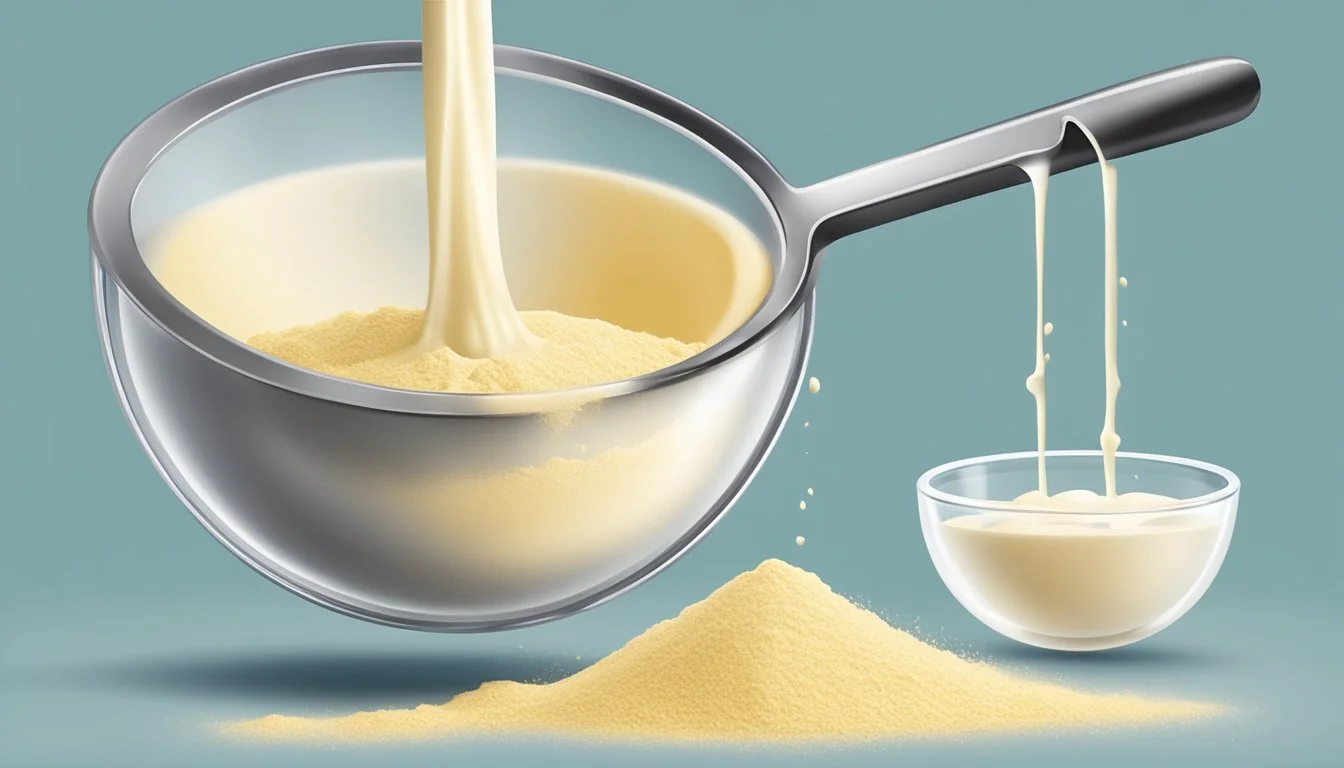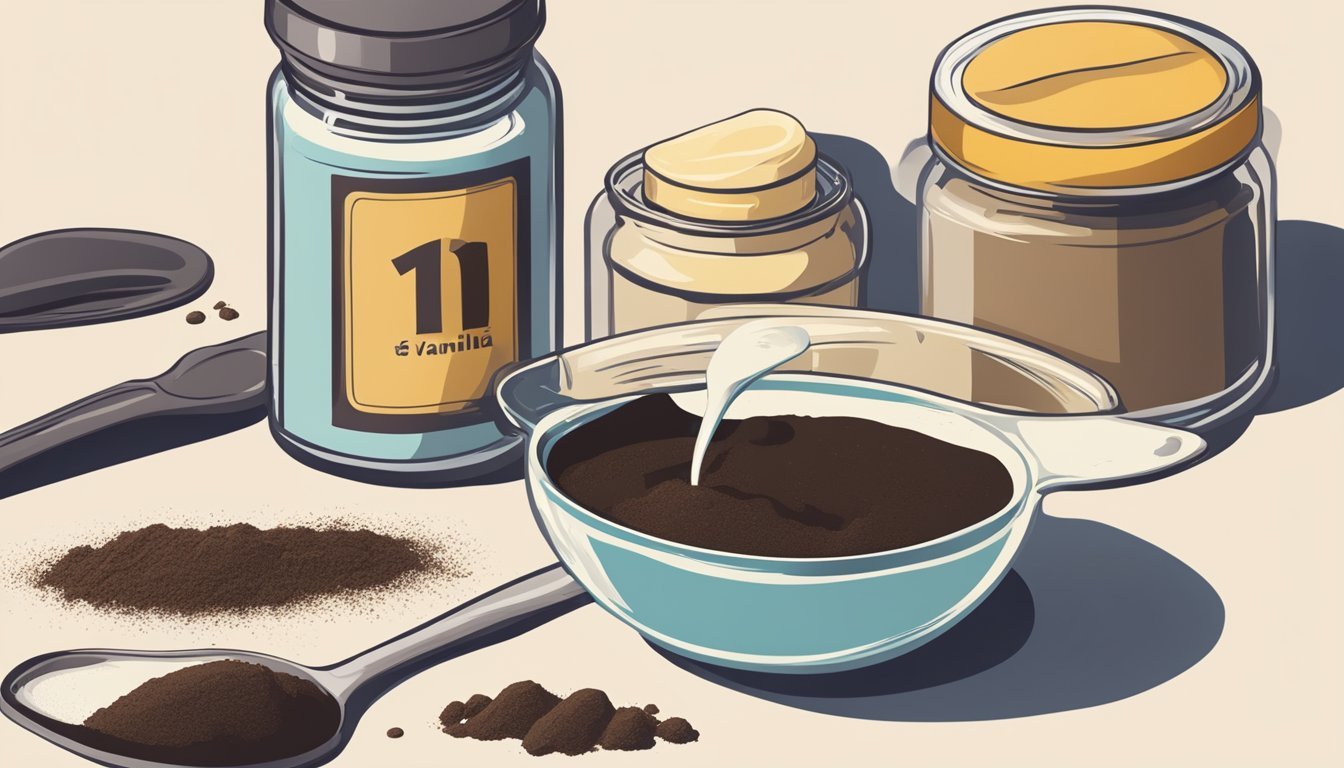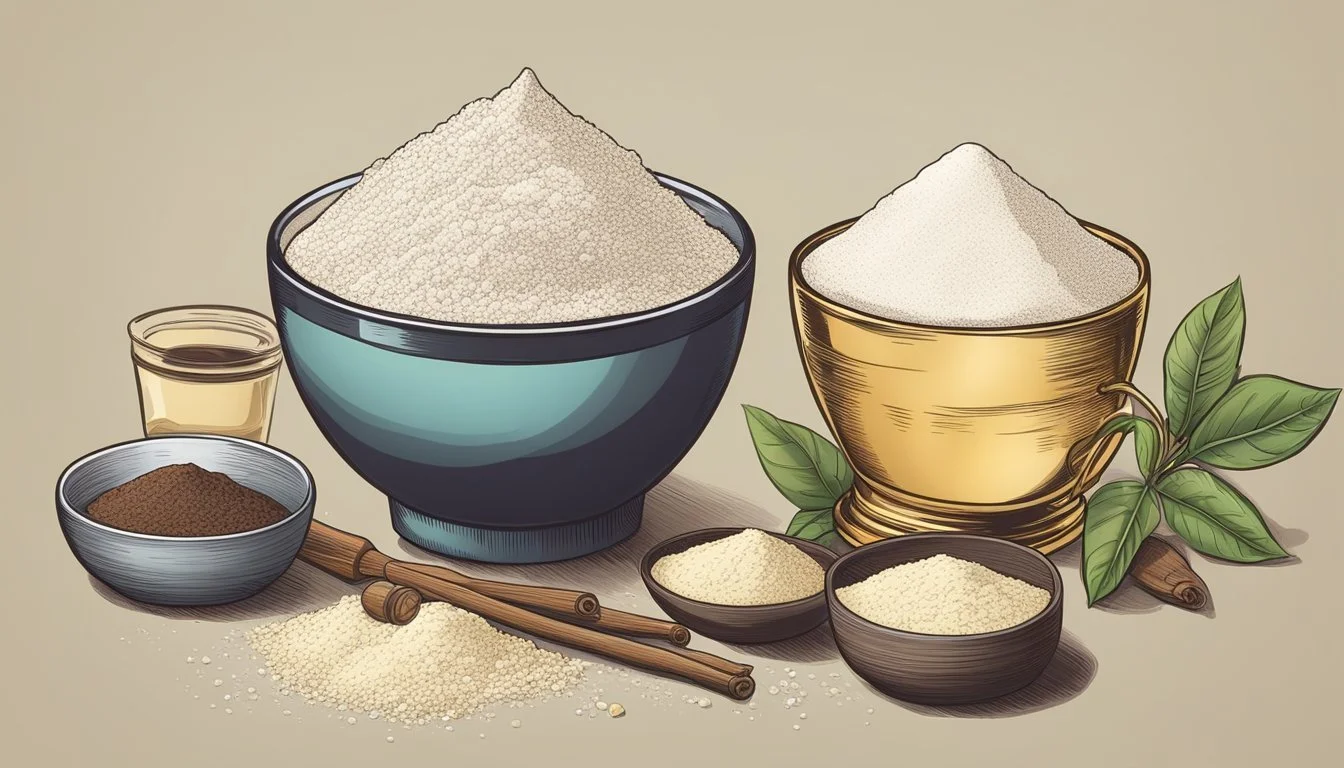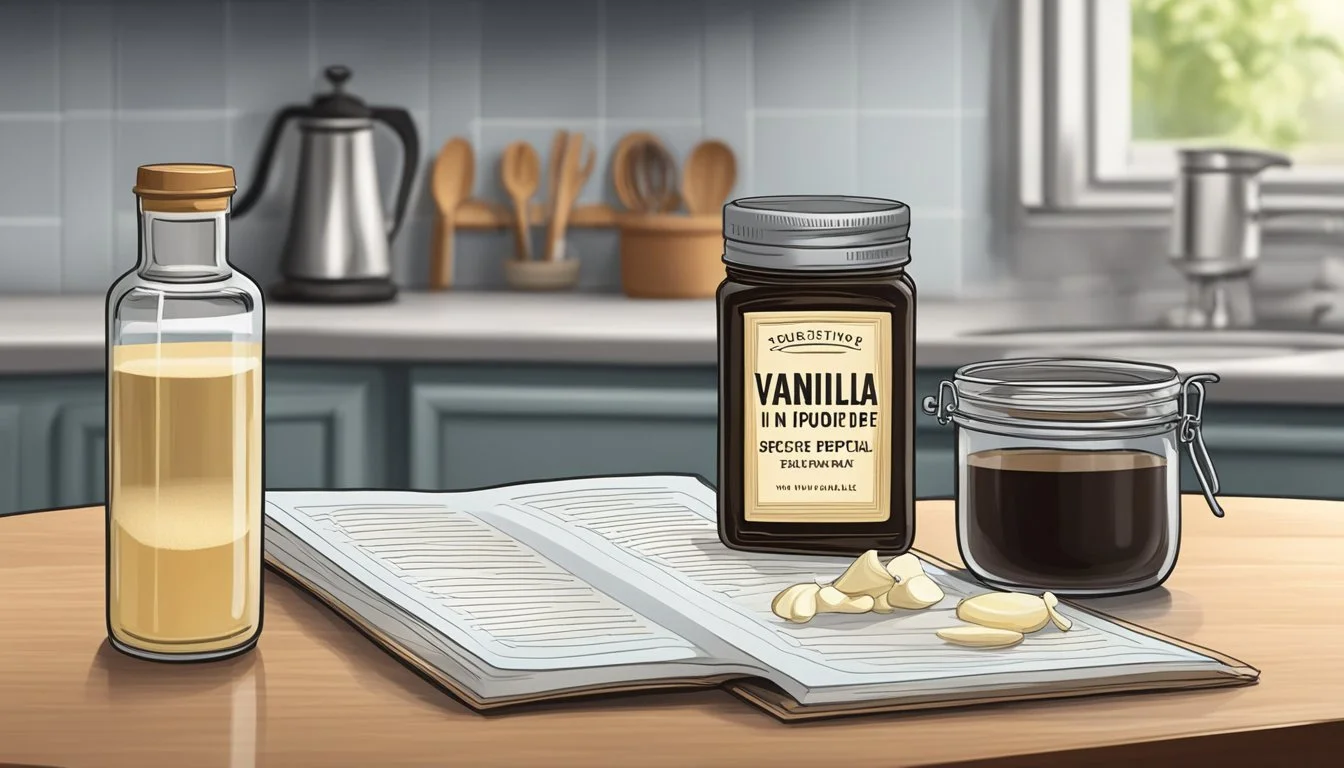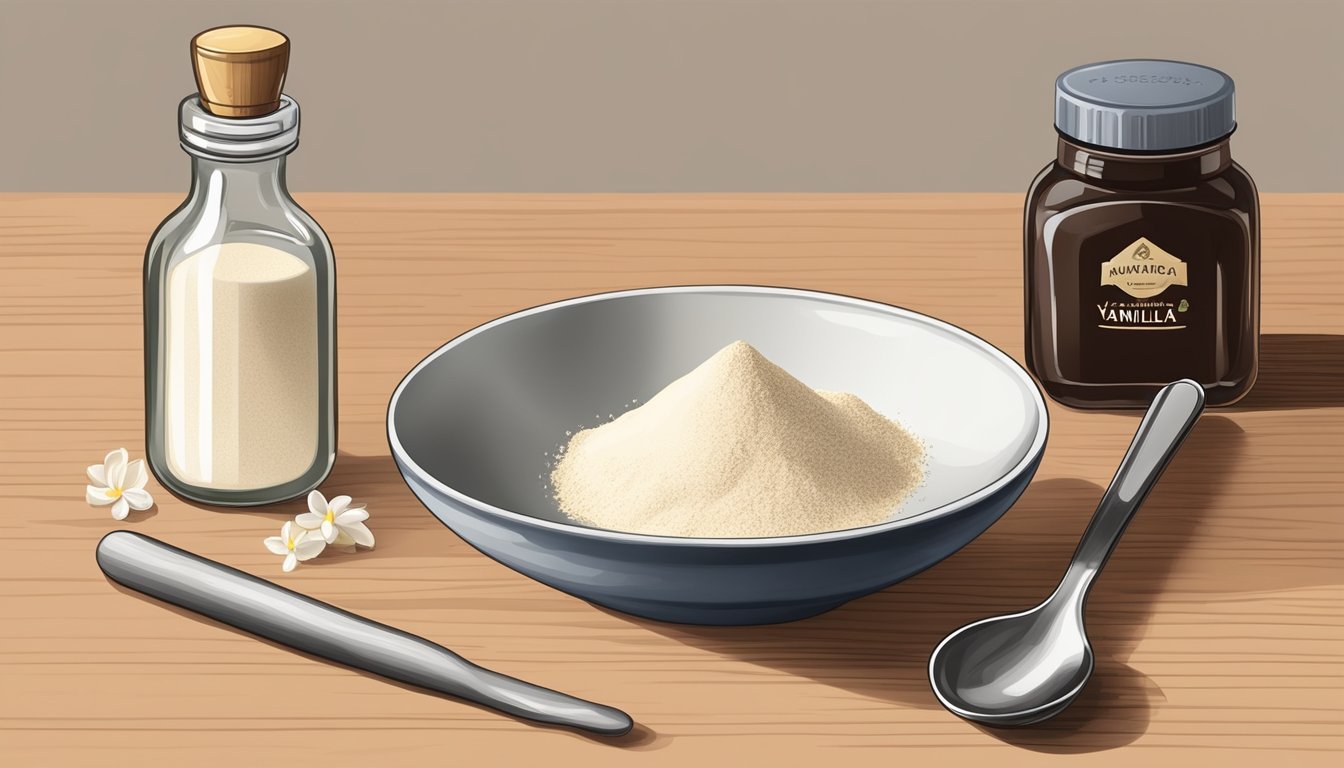How to Substitute Vanilla Powder for Vanilla Extract
A Simple Conversion Guide
When baking or preparing desserts, the flavor of vanilla is often a key ingredient, imparting a sweet, aromatic essence that's instantly recognizable. While vanilla extract, a solution made by macerating and percolating vanilla beans in a solution of ethyl alcohol and water, is widely used for its strong flavor and ease of incorporation, vanilla powder presents an alternative for those seeking a non-liquid form or an alcohol-free option. Vanilla powder, made from dried and ground vanilla beans, provides a similarly rich flavor without the alcohol content, making it suitable for recipes where liquid content must be controlled or for dietary preferences that exclude alcohol.
Substituting vanilla powder for vanilla extract can be straightforward, but it requires understanding the ratio and how the change may affect the recipe. A common substitution ratio is one-half teaspoon of vanilla powder for every teaspoon of vanilla extract. This direct swap preserves the vanilla flavor without altering the moisture balance of the recipe. Because vanilla powder is finely ground, it can easily blend into the dry ingredients, ensuring a uniform distribution of vanilla flavor throughout the dish.
Choosing to use vanilla powder over vanilla extract can also affect the visual presentation of the final dish. Unlike vanilla extract, vanilla powder includes the tiny vanilla bean specks that can enhance the aesthetic of light-colored baked goods with a speckled appearance. It's particularly beneficial in recipes like white cakes (how long do cakes last?) or frostings where bakers may prefer not to add the slightly brown tint that vanilla extract can impart. Despite these differences, both forms of vanilla offer the warm, rich taste that is essential in many sweet recipes.
Understanding Vanilla Flavor
Intrinsic to countless recipes, vanilla flavor is synonymous with sweetness and warmth, often forming the aromatic foundation in both culinary and scented products. With several forms available, understanding each type's origin and application is crucial for cooking and baking enthusiasts.
The Origin of Vanilla Flavor
Vanilla flavor primarily originates from vanilla beans, which are the long, slender fruits of the orchid species Vanilla planifolia. Its complex flavor profile is attributed to a compound called vanillin, along with hundreds of other compounds. Traditionally, vanilla beans undergo a lengthy curing process, which develops their characteristic flavor. Regions like Madagascar, Mexico, and Tahiti are famous for their cultivation, each imparting subtle flavor differences due to variations in soil and climate.
Forms of Vanilla
Vanilla comes in numerous preparations, each suited for specific culinary applications:
Vanilla Extract: A solution of vanilla beans steeped in alcohol and water, capturing the bean's full range of flavors.
Pure vanilla extract contains only natural vanilla flavor derived from real beans.
Imitation vanilla extract usually derives its flavor from synthetic vanillin.
Vanilla Powder: Finely ground, dried vanilla beans without any additional alcohol or sugar.
Replace 1 teaspoon of vanilla extract with 1/2 teaspoon of vanilla powder.
Vanilla Bean Pods: Whole vanilla beans that can be split and scraped to release the seeds and potent inner pulp.
Vanilla Paste: A thick blend of vanilla extract, vanilla bean seeds, and sometimes sugar or sweeteners.
Utilize in a 1:1 ratio as a substitute for extract.
Vanilla Sugar: Sugar infused with vanilla flavor, used as a sweetener with subtle vanilla essence.
In baking and cooking, recipe considerations, such as heat, moisture, and desired visual appearance, guide which form of vanilla is most appropriate. For instance, vanilla powder might be preferred when an alcohol-free or clear mixture is needed, while vanilla extract could be favored for its ability to meld seamlessly into liquids.
The Basics of Substitution
When substituting vanilla powder for vanilla extract, understanding the correct ratios, the impact on taste and texture, and how to adjust recipes is essential for a successful outcome.
Substitution Ratios
For most recipes, the substitution ratio of vanilla powder to vanilla extract is 1:2. This means that for every teaspoon of vanilla extract called for, one should use only one-half teaspoon of vanilla powder.
Vanilla Extract Vanilla Powder 1 teaspoon 1/2 teaspoon 2 teaspoons 1 teaspoon 1 tablespoon 1 1/2 teaspoons
Taste and Texture Considerations
Vanilla powder and vanilla extract can impart different qualities to a dish. Vanilla powder, being alcohol-free, may provide a more mellow flavor profile compared to the slightly sharper notes of alcohol-based vanilla extract. Additionally, since vanilla powder is a dry ingredient, it does not add moisture to recipes, which could be important in baked goods or dry mixes.
Adjusting Recipes for Powder
When using vanilla powder in place of liquid vanilla extract, a baker may need to make slight alterations to the recipe to account for the lack of added liquid. This could involve increasing wet ingredients slightly or reducing dry ingredients. Care should be taken when folding vanilla powder into mixtures as it is fine and can clump. One could sift the powder with other dry ingredients to ensure an even dispersion throughout the batter or dough.
Vanilla in Baking and Cooking
When adapting recipes, it is vital to understand the roles vanilla extract and vanilla powder play in both baking and cooking. Substituting one for the other requires careful measurement and consideration of the differences in flavor intensity and the physical properties of these vanilla forms.
Baking with Vanilla Powder
In the realm of baking, vanilla serves as a crucial flavor enhancer, working synergistically with other ingredients to create a depth and complexity of flavor. While most recipes call for vanilla extract, vanilla powder can be used as an alternative, especially in dry mixes for cookies, cakes, and other baked goods.
Ratio: As a rule of thumb, substitute 1/2 teaspoon of vanilla powder for every 1 teaspoon of vanilla extract called for in a recipe.
Consistency: Since vanilla powder is dry, it does not affect the wet-to-dry ingredient ratios, making it an excellent choice for recipes that require precise measurements.
Cooking with Vanilla Powder
Vanilla powder shines in cooking applications, especially when a recipe requires a pure, unadulterated vanilla flavor without the addition of liquid. It can be ideal for flavoring custards (how long do custards last?), pies, and various types of desserts where the moisture content needs to remain controlled.
Flavor: Vanilla powder imparts a rich, robust flavor without the alcohol present in extracts.
Versatility: It's easily incorporated into sugar for an infused sweetener or used directly in savory or sweet dishes where liquid content is critical.
By keeping these specifics in mind, cooks and bakers can successfully incorporate vanilla powder into their culinary creations, achieving delicious outcomes with the nuanced, fragrant essence of vanilla.
Pairing Vanilla with Other Ingredients
When substituting vanilla powder for vanilla extract, understanding the synergistic relationship between vanilla and other ingredients can elevate the flavors of a recipe. Vanilla acts as a flavor enhancer, blending seamlessly with a variety of spices, sweeteners, and alcohols to create a complex taste profile.
Complementary Spices and Sweeteners
Vanilla pairs exceptionally well with an array of spices and sweeteners. Chocolate, a beloved ingredient, benefits from vanilla’s ability to round out its bitterness, enhancing its rich and indulgent flavor. When using vanilla powder, consider its concentrated nature and opt for half the amount compared to extract. Vanilla synergizes with sugar to enhance sweet notes, which can be further amplified by converting the sugar into vanilla sugar — sugar infused with vanilla's essence.
Here’s a list of corresponding spices and sweeteners and how they interact with vanilla:
Cinnamon: Enhances warmth, ideal for baked goods.
Maple Syrup: Provides a rustic sweetness, perfect for breakfast items.
Pure Maple Syrup: Imparts a rich, authentic sweetness alongside vanilla.
Honey: Offers a floral note that complements vanilla's sweetness.
Incorporating vanilla powder with these complementary ingredients should be done to taste, keeping in mind vanilla’s ability to intensify their flavors.
Vanilla and Alcohol
Vanilla also pairs remarkably with various alcohols, bringing out their hidden nuances. Bourbon and rum, known for their caramel-like undertones, match well with vanilla’s warm notes. Vanilla powder can be added directly to batters and custards that already contain these spirits to create depth.
A concise table reflecting alcohol pairings:
Alcohol Amount of Vanilla Powder Notes Bourbon 1/2 tsp per tsp extract Complements vanilla with its oakiness. Rum 1/2 tsp per tsp extract Elevates vanilla's natural sweetness. Brandy 1/2 tsp per tsp extract Adds a sophisticated depth to desserts. Almond Extract Use sparingly Can overpower, so adjust vanilla accordingly.
Adding amaro, a less common but intricate liqueur, can introduce a bittersweet complexity to the profile where vanilla serves as a sweet counterpoint. The rich, complex flavors of coffee and amaro can be balanced elegantly with the addition of vanilla powder, making it an indispensable component in both confectionery and savory applications. However, because these alcohols also possess strong flavors of their own, they should be used in moderation alongside vanilla to achieve a harmonious blend.
Substituting Vanilla in Special Cases
When traditional vanilla extract isn't suitable due to allergies, dietary choices, or supply issues, alternatives like vanilla powder area practical solution. Vanilla powder is versatile, allowing it to adapt to various special cases without compromising flavor.
Allergy and Dietary Restrictions
Vanilla extract typically contains alcohol, which might not be suitable for those with allergies or dietary restrictions. Vanilla powder, on the other hand, is alcohol-free, making it an excellent option for those avoiding alcohol. Additionally, the warm and floral notes of pure vanilla powder can enhance dishes with a similar profile to that of the extract. When shopping, one can look for imitation vanilla powder at the grocery store, but they should be aware that it may contain additives that could trigger allergies. It's essential to check the ingredient list for potential allergens. Here's a quick guide for substitution:
Pure Vanilla Powder: Use ½ teaspoon to replace 1 teaspoon of vanilla extract.
Imitation Vanilla Powder: Check the manufacturer's recommendations, as potency varies.
Dealing with Supply Constraints
In times when vanilla extract is hard to come by or if one seeks a more affordable option, vanilla powder can be a suitable substitute. Unlike some liqueur-based substitutes that might be used in a pinch, vanilla powder keeps things simple and cost-effective. For those looking to add sweetness without a liquid sweetener, vanilla powder can double as a flavor enhancer and sweetener in dry mixes without altering the texture. Here's how to make the swap:
Cakes and Cookies: Directly substitute vanilla powder in half the amount of extract required.
Homemade Mixes: Incorporate vanilla powder with dry ingredients for an infused flavor.
By understanding these substitutions, one can navigate around common vanilla-related obstacles with confidence, ensuring delicious results in any situation.
Exploring Vanilla Alternatives
When substituting vanilla powder for vanilla extract, one must consider flavor potency and recipe suitability. Vanilla powder offers a flavorful, alcohol-free option with a different set of characteristics compared to liquid extract, while vanilla paste, liqueur, and other alternatives possess unique textures and flavor profiles that can complement various recipes.
Using Vanilla Bean Paste and Liqueur
Vanilla Bean Paste often contains a blend of vanilla extract and vanilla seeds, offering the rich flavor of vanilla beans with the convenience of a scoopable paste. For every teaspoon of vanilla extract, a half teaspoon of vanilla bean powder or an equal amount of vanilla bean paste can be used, ensuring the essence of vanilla is not lost in baked goods.
On another note, Vanilla Liqueur and spirits like rum, brandy, or bourbon serve as an enveloping substitute, especially in recipes where a hint of alcohol can enhance the overall taste. A tablespoon of these aromatic alcohols can replace a tablespoon of vanilla extract, blending seamlessly into cakes or custards.
Homemade Vanilla Extract
Creating Homemade Vanilla Extract can be a rewarding alternative, requiring only vanilla beans and alcohol, such as vodka. The process involves:
Splitting vanilla beans lengthwise to expose the seeds.
Submerging the split beans in alcohol.
Sealing the mixture in a jar and storing it in a cool, dark place.
Shaking the jar occasionally and waiting for at least 8 weeks for full infusion.
The result is a custom-made extract with a robust vanilla flavor that can be used in a direct 1:1 substitution ratio for store-bought extracts.
Imitation Vanilla and Other Flavorings
Imitation Vanilla Flavoring, or essence, while budget-friendly, provides a vanilla flavor without using real vanilla beans. It's synthesized from wood byproducts and includes artificial flavorings. However, it might be less potent than real vanilla, so some adjustments may be necessary to achieve the desired taste.
For those looking to avoid alcohol or synthetic ingredients altogether, there's Vanilla Sugar—sugar infused with vanilla—acting both as a sweetener and flavor enhancer. To substitute, one can use:
1 tablespoon of vanilla sugar for every teaspoon of vanilla extract,
Adjust the overall sugar content in the recipe accordingly.
Remember, each alternative may affect the texture and outcome differently, so it's wise to consider the specific requirements of your recipe when choosing a substitute for vanilla extract.
Practical Tips and Tricks
When substituting vanilla powder for vanilla extract, the key points to focus on are accurate measurement, maintaining the desired appearance of the final product, and optimizing the flavor.
Measuring and Storage
To achieve the best results, one should measure correctly. Vanilla powder is potent, and a general rule of thumb is to use half the amount of vanilla powder to vanilla extract. For example:
1 teaspoon vanilla extract = 1/2 teaspoon vanilla powder
Storage is critical for maintaining the vanilla powder's shelf life. It should be kept in an airtight container, away from light and moisture, which can impact both flavor and texture.
Adjusting for Color and Presentation
Vanilla powder, unlike vanilla extract, does not add color to the mixture. It is a great option when a clear or pure white color is desired, such as in icings or whipped cream. Additionally, the powder does not contain the little black flecks like a vanilla bean, but it can be sprinkled on top of beverages like hot chocolate or certain baked goods for a visual appeal.
Enhancing Flavor Profiles
Vanilla powder works exceptionally well with dry mixtures and in recipes subjected to high temperatures since it is granulated and heat-stable. Its inclusion in recipes like cookies or cakes can intensify the flavor, as the powder distributes more evenly than extracts.
Remember, vanilla powder can clump, so it's essential to sift it with other dry ingredients such as granulated sugar or flour, enhancing the flavor profile by ensuring a uniform distribution throughout the batter or mixture.
Creative Uses for Vanilla Powder
Vanilla powder offers a potent and convenient flavoring alternative to extracts, seamlessly blending into various culinary creations to impart its rich essence. With no alcohol content present, it is ideal for recipes where the addition of liquid may alter the desired consistency.
Crafting Beverages
In the realm of beverages, vanilla powder serves as an excellent flavor enhancer. Baristas might find it valuable for dusting over frothy espresso drinks or blending into frappés to complement the boldness of the coffee. For homemade milkshakes, particularly vanilla ice cream-based shakes, a pinch of vanilla powder can intensify the vanilla flavor without thinning the creamy texture.
Example Recipes
Spiced Vanilla Latte: Stirring a small amount of vanilla powder into a mixture of milk and espresso powder delivers a warm, comforting drink with a rich aroma.
Peppermint Mocha: Vanilla powder pairs with peppermint to create a festive twist on a classic mocha during the holiday season.
Seasonal Treats
During festive occasions, vanilla powder effortlessly infuses sweetness into seasonal confections. Sprinkling the powder onto sugar cookies before baking can leave a beautifully flavored finish that's more pronounced than with vanilla extract. And within fruit pies, a blend of vanilla powder and lemon zest can balance the tartness of the fruit with a subtle, yet full, vanilla flavor.
Example Desserts
Holiday Sugar Cookies: Incorporating vanilla powder in sugar cookie dough before baking results in evenly dispersed vanilla flavor throughout.
Lemon Vanilla Berry Pie: A light dusting of vanilla powder over the berries, mixed with a handful of lemon zest, elevates the pie with a sophisticated twist.
Exotic and International Desserts
Vanilla powder is versatile in international pastry recipes, shining particularly well in desserts from regions like Mexico and Tahiti where vanilla is celebrated. It melds beautifully into delicate pastries and rich cakes, seamlessly blending with other intricate flavors.
Example Desserts
Mexican Tres Leches Cake: Vanilla powder intermingles with the three types of milk, enhancing the cake's flavor profile without altering its moisture balance.
Tahitian Vanilla Panna Cotta: Using vanilla powder can mirror the exotic taste of Tahitian vanilla, deeply infusing the custard with its signature smooth, floral notes.
FAQs About Vanilla Powder and Extract
When substituting vanilla powder for vanilla extract, precision is key due to their differing potencies and compositions. This section addresses common inquiries to ensure the proper application in various culinary contexts.
Addressing Common Questions
What is the difference between vanilla extract and vanilla powder?
Vanilla extract is a solution made by infusing alcohol, typically vodka, with vanilla beans, whereas vanilla powder is made from dried and ground vanilla beans. The powder is devoid of alcohol and typically doesn't contain the small, black vanilla seeds found in the extract.
Can you substitute vanilla powder for vanilla extract in baking?
Yes, you can substitute vanilla powder for vanilla extract in baking. Generally, half a teaspoon of vanilla powder equates to one teaspoon of vanilla extract. Since vanilla powder has a more concentrated flavor and lacks the liquid content of the extract, adjustments might be required for the recipe's moisture balance.
Is vanilla powder stronger than vanilla extract?
Yes, vanilla powder is often more potent than vanilla extract due to its undiluted form. It imparts a rich vanilla flavor without the additional moisture, making it ideal for dry applications, like enhancing sugar or cookie dough mixtures.
Which vanilla option is better for recipes that involve high heat?
Vanilla powder is preferable in recipes involving high heat, such as making brownies, since it is less prone to flavor loss due to evaporation, compared to vanilla extract that contains alcohol.
What benefits does vanilla powder have over extract in applications beyond baking?
Vanilla powder can be beneficial in non-baked goods where moisture content is critical. Its use prevents the potential for seizing in chocolate or can contribute an earthy note to complex spice blends, like those containing cardamom.
Are there premium brands of vanilla powder, like there are for vanilla extract?
Premium vanilla brands such as Nielsen-Massey and Heilala offer high-quality vanilla options, including extracts and, in some cases, powders or pastes sourced from places like Madagascar, known for exceptional vanilla beans.
How can I use vanilla powder in recipes that call for a liquid sweetener, like syrup or honey?
To maintain balance in recipes requiring a liquid sweetener, you can incorporate vanilla powder into the dry ingredients or alongside the sugar. This allows the vanilla flavor to be well-distributed without altering the liquid ratio.
Conclusion
When substituting vanilla powder for vanilla extract, it's essential to consider the recipe's requirements and the flavor intensity desired. Vanilla powder is more concentrated and imparts a stronger vanilla flavor without the alcohol present in extracts. Bakers typically recommend using half the amount of vanilla powder compared to extract. So, a conversion ratio of 1:2 (vanilla powder to vanilla extract) works well in most cases.
For every teaspoon of vanilla extract, one can substitute with a half teaspoon of vanilla powder. However, altering this ratio slightly depending on the recipe's sensitivity to moisture and flavor can be beneficial.
For baked goods like cakes and cookies:
1/2 teaspoon vanilla powder = 1 teaspoon vanilla extract
For liquid-based recipes or those that require sugar:
Adjustments may be necessary to account for the lack of liquid and sweetness from the extract.
In recipes where the small black specks of vanilla seeds are desirable for appearance, using vanilla powder satisfies this aesthetic, as it contains these tiny seeds. Additionally, vanilla powder is ideal for dry mixes and as a flavoring for beverages where one wishes to avoid added moisture.
Remember that the quality of the vanilla product greatly affects the outcome. High-quality vanilla powder can provide an exceptional depth of flavor. Therefore, one should select the vanilla product wisely to ensure the best results for their culinary creations.

